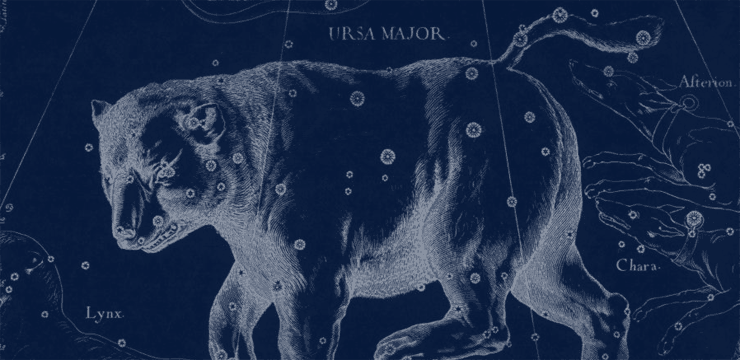
The Circumpolar Constellations
June 2011 :
We normally spend a lot of time enjoying the seasonal constellations, the ones that our ancestors depended on as indicators of changes here on Earth, but we often forget that there is a set of star patterns that are always there, waiting for us when we turn around to the north. These are the circumpolar constellations, the ones that, although their positions do change with time, they seem to travel in a circle centered at the sky’s north pole, and are always visible from our northern latitudes.
Most evident is the Big Bear, Ursa Major. This pattern is so easily seen as a bear that cultures all over the Earth saw this part of the sky as a huge mammal, a big brown bear throughout much of central Europe, a polar bear for those in the Scandinavian countries, either a bear or other cuddly woodland creature in North America; however, in Thailand, your imagination gets a little stretched - there it was a crocodile.
Unfortunately, our lit skies have erased much of the animal in cities, but the back end of the bear, the Big Dipper, can still be made out everywhere. Five of these seven stars are actually a part of a cluster of stars called an association. One of these, the star at the crook of the handle, Mizar, was the eye test for Greek soldiers. Look closely near this star - if you can see a dimmer star right next to it, your eyes are good enough for battle. Dimmer Alcor, although it seems to be a close neighbor to Mizar, is in fact much farther away, and only in the same direction. This is referred to as an optical double.
The two stars at the outside edge of the dipper lead us to the most important star in the Northern Hemisphere, the one just a couple degrees off the North Celestial Pole, Polaris, the North Star. Most are very surprised to learn that its importance isn’t its brightness, just its position, close enough to seem to remain stationary in the northern part of the sky. It is also just within a couple degrees of your latitude. Polaris is also at the end of the tail of Ursa Minor, the Little Bear, but this constellation is so dim, and so much smaller than the Big Bear, that you will have a very tough time finding an animal in this part of the sky. And, just as the Big Bear has its dipper, within this bear is the Little Dipper, although near impossible to see in city skies. As an aid, think of both dippers as placed in pour position; they are angled such that the fluid in their bowls will pour into each other.
Continuing the line from the Big Dipper to Polaris will take you to what at first glance might be a capital M or W, but look closely at the central star, and you should see another star, dimmer, but still visible from the city. This star will change the shape of this pattern from a letter to a chair. You have found Cassiopeia, the Lady in the Chair. Cassiopeia was a beautiful queen who liked to remind her subjects of this. But it wasn’t until she started saying she was much better looking than the guardians of Neptune that she found herself in trouble. Jupiter sat her in a chair and placed her in the sky in such a position that for half the year, when you look toward the north, you will see the chair upside-down; Cassiopeia must fight to stay in her chair, or land back on Earth face first. After a while it was decided to send her husband, Cepheus, up into the sky to keep her company. He is the very dim clown head shape located right next to her. Simply draw a line from the two stars at the bottom of each chair leg to find him.
Going back to the two pointer stars of the Big Dipper, this time only go up one distance from them. The star you find is the end of Draco, the Dragon. If you have seen the Movie “Dragonheart,” you might have actually seen the constellation as it’s positioned in the sky. Beginning just above the Big Dipper, this mythical animal follows the curves of both dippers, with his head a crooked square, the asterism the Lozenge, curling back onto itself.
There’s also a very dark part of the northern sky that at first might seem to not have any stars in it at all. As every part of the sky must belong to a constellation, this dim little area has been designated Camelopardalis, the camel-leopard, or, as it is familiarly known, the giraffe. At times, it seems our ancestors had unique senses of humor.
When to Observe
Constellations
Related Topics




